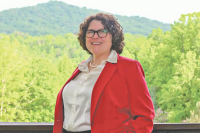This group might have some bite — watchdog group formed to monitor WCU
It just wouldn’t be the Jackson County we’ve all come to know and love if there wasn’t some kind of community-action group watchdogging Western Carolina University’s attempts to create its very own incorporated town.
But it’s Jackson County, so of course, there’s now such a group — with the working name of the Cullowhee Coordinating Committee.
“The school, in the past, has behaved as if this is Cullowhee,” Robin Lang, the group’s spokeswoman, said one day last week, gesturing toward the university.
But, she argued, that’s not all of Cullowhee. The people who live in the area are Cullowhee, too. So are the local businesses, and the many people who have invested time and emotional energy into the university and into the area around WCU. All of these people and institutions, Lang said, deserve to be heard before something is done to change what they claim as theirs, too.
Some issues the group might look into:
Possible legal sales of alcoholic beverages — how will local restaurants compete if they can’t do the same? Are there Cherokee archaeological sites? Any Indian burials around WCU, or perhaps an old village or two? Environmental questions also abound — does the proposed Town Center have wetlands within its 35-acre tract, like some are claiming gave way during the building of the Ramsey Center? Are there ways to accomplish revitalization goals along Old Cullowhee Road without annexation?
A bit of background.
WCU, under the leadership of Chancellor John Bardo, is attempting to pair with its tiny neighbor, the 1997-incorporated Village of Forest Hills, to create a college town that would probably be called Cullowhee. Forest Hills is made up of fewer than 400 residents, most being current or retired faculty and staff of the university. (In an interesting twist of irony, the Village of Forest Hills — which has no town hall or services to speak of, though it does contract some police protection — incorporated for one simple reason: to stave off students from taking over the community.)
WCU wants Forest Hills to voluntarily annex university land as the town center. There, Bardo has said, there would be commercial development, with leases extended to restaurants, bookstores, coffee shops and such, as well as condos and a few university offices. That vision has not included much in the way of local businesses — franchise restaurants have been mentioned, not such campus fixtures as the Mad Batter Bakery and Café or its ilk.
WCU bought 2.2 acres on Centennial Drive in January 2007 that houses the Mad Batter, a Subway sandwich shop, and several other commercial businesses.
Forest Hills Mayor Jim Wallace indicated last month that town aldermen were expecting to receive information from WCU soon on how the town could best accommodate a mixed-use land plan.
Tom McClure, director of the office of partnership development for the WCU Millennial Initiative, said there are some “internal discussions” taking place, and that it could be a matter of weeks before the necessary documents are ready for review.
McClure said he has prepared a draft, but that it is not yet ready for review. McClure said a 20-year or more development agreement is key. A “planned-unit development” would eliminate the need for each new business involved to get individual approval from the town.
Chancellor John Bardo has said WCU will ask town leaders to adopt wholesale the university’s design for a town center.
WCU’s desire to create a commercial hub and vibrant college town hinges on its tiny neighbor. Cullowhee is not currently incorporated as a town, and as a result, stores and restaurants can’t sell beer, wine or liquor drinks. That has proved a major stumbling block in attracting commercial ventures typically associated with college towns.
Get involved
The next meeting of the Cullowhee Coordinating Committee will be Thursday, Nov. 18, at 2 p.m. in WCU’s Honors College conference room. The meeting will last an hour.
Forest Hills in holding pattern on WCU annexation
A timetable is still being hammered out on when Forest Hills leaders will receive a formal proposal from Western Carolina University on annexing land for a commercial development.
WCU wants to develop 35 acres of its main campus into a “town center,” which would be leased to restaurants, bookstores, coffee shops and the like, as well as condos and a few university offices. Forest Hills has been asked to annex the land into its town limits.
Forest Hills Mayor Jim Wallace indicated last month that town aldermen were expecting to receive information from WCU soon on how the town could best accommodate a mixed-use land plan.
Tom McClure, director of the office of partnership development for the WCU Millennial Initiative, said there are some “internal discussions” taking place, and that it could be a matter of weeks before the necessary documents are ready for review.
McClure said he has prepared a draft, but that it is not yet ready for review. McClure said a 20-year or more development agreement is key. A “planned-unit development” would eliminate the need for each new business involved to get individual approval from the town.
Chancellor John Bardo has said WCU will ask town leaders to adopt wholesale the university’s design for a town center.
WCU’s desire to create a commercial hub and vibrant college town hinges on its tiny neighbor. Cullowhee is not currently incorporated as a town, and as a result, stores and restaurants can’t sell beer, wine or liquor drinks. That has proved a major stumbling block in attracting commercial ventures typically associated with college towns.
The Village of Forest Hills consists of fewer than 400 residents. Most are current or retired faculty and staff of the university. The town incorporated in 1997, mainly to prevent an influx of students from taking over the community.
Clark Corwin, a council member for Forest Hills, said he would like to see his town receive extensive feedback from residents before any decisions are made. This includes, he said, whether to allow alcoholic beverages to be sold.
He said Southwestern Development Commission, a state regional planning and development organization, offers a tidy process through the Mountain Landscapes Initiative that might work well for Forest Hills. A toolbox has been developed offering best practices and guidelines for sustainable growth.
“I think everyone is of a mind to have a public forum, but I want something more than just a public hearing,” Corwin said.
Mountain Heritage Day to offer continuous entertainment, new Children’s Tent
The talents of Western North Carolina’s top traditional musicians and singers will be showcased during the 36th annual Mountain Heritage Day, coming up Saturday, Sept. 25, on the campus of Western Carolina University.
The festival’s newly named “Mountain” and “Heritage” stages will feature 22 separate musical acts that will provide constant free entertainment from 10 a.m. to 5 p.m., said festival coordinator Trina Royar.
“Our schedule of performers for the two stages includes bluegrass, old-time music, bluegrass-gospel, traditional Irish music, traditional and contemporary folk, and traditional country. If you like music in the ‘traditional’ genre, we’ve got you covered,” Royar said.
The entertainment lineup includes regional bluegrass favorites Balsam Range, Whitewater Bluegrass Co., Buncombe Turnpike and the Stoney Creek Boys, as well as the traditional and contemporary folk sounds of Phil and Gaye Johnson, old-time music by Jackson County’s Queen and Deitz families, and the Red Wellies, a traditional Irish band from Asheville.
Also, Mountain Heritage Day will feature four clogging teams, with two teams performing on each stage, Royar said.
Other musical performances are scheduled at the festival’s Circle Tent, a venue designed to provide visitors with a workshop kind of experience, Royar said. The Banjo Circle will feature area banjo pickers Mark Pruett, Junior Queen and Steve Sutton. The Fiddle Circle will highlight the talents of Trevor Stuart, Delbert Queen, Danielle Bishop, Beanie O’Dell and Arvil Freeman, and the Mandolin Circle will feature Adam King, Danny Bishop, Barry Clinton and Darren Nicholson. WCU’s own student group, the Porch Music Club, will lead an open jam at the Circle Tent at 3:30 p.m.
While the music and dancing is going on at the two main stages and in the Circle Tent at Mountain Heritage Day, a new performance area, the Children’s Tent, will offer younger festival visitors a wide range of activities, Royar said.
WCU’s 36th annual Mountain Heritage Day set for Saturday, Sept. 25
The traditional folkways of the Southern Appalachian Mountains will once again take center stage as the Western Carolina University community presents the 36th annual Mountain Heritage Day on Saturday, Sept. 25.
WCU’s annual festival offers a smorgasbord of traditional mountain culture, with a variety of music, dance, crafts, folk arts, contests and activities that is hard to find in a one-day event, said festival coordinator Trina Royar of WCU’s Mountain Heritage Center.
All Mountain Heritage Day activities, including stage performances, will take place between 10 a.m. and 5 p.m., with the exception of the 5-K footrace, which begins at 8 a.m., and registration for the woodcutting contest, which starts at 9 a.m. This year’s festival will be held on fields behind the Cordelia Camp Building, in parking lots and grassy areas around the Camp Building, and in the nearby Mountain Heritage Center, which is located on the ground floor of H.F. Robinson Administration Building.
Each year’s Mountain Heritage Day is the result of months of planning and work by a host of volunteers representing WCU’s student body, faculty and staff, and all that activity culminates with a busy festival day on the last Saturday in September, Royar said. “In particular, the event requires a big commitment by the university’s police force and facilities management department, but the payoff comes for everyone involved with the festival when they see the big crowds and smiling faces at WCU’s largest one-day event,” she said.
See also: Mountain Heritage Day to offer continuous entertainment, new Children’s Tent
Arts, crafts and food
Visitors at this year’s Mountain Heritage Day will find 80 booths of juried arts and crafts, providing a perfect opportunity for local residents to get in some early holiday shopping, Royar said. Items for sale will include everything from ceramics and wood carvings to basketry, jewelry and metalwork. Beginning this year, the layout of the arts and crafts vendor area has been redesigned to provide for a more pleasant shopping experience, with each vendor having a “corner” booth with two open sides. Fifty-nine percent of the arts and crafts vendors at this year’s festival are from Buncombe and other N.C. counties to the west, Royar said.
About 20 food vendors also are scheduled to participate in the festival, offering festival-goers tempting options such as Cherokee frybread, gyros, angus beef burgers, kettlecorn and ice cream.
Stickball and blowguns
The traditional Cherokee game of stickball has been a favorite attraction for festival visitors in recent years, and the Snowbird Stickball Team from Graham County will make its first appearance at Mountain Heritage Day to demonstrate that ancient sport. Before the two dozen members of the team begin play at 11 a.m., they will “take to the waters” of nearby Cullowhee Creek as an act of purification, said team leader Charles “Shorty” Kirkland.
Another Native American tradition will be demonstrated at 1 p.m. when team members join with their female associates in playing the courtship game of “Fish.” Male players use sticks to throw a ball up to hit a wooden fish that sits atop a 24-foot pole, while the female players are allowed to use their hands to throw the ball. Also, the females are allowed to physically harass the male players, “but the man has to be a perfect gentleman,” Kirkland said.
The Snowbird team also will demonstrate the use of traditional Cherokee blowguns at 3 p.m.
Music & clogging
For fans of traditional music and clogging, life doesn’t get much better than the two main stages of Mountain Heritage Day, which will offer continuous free entertainment from 10 a.m. to 5 p.m., Royar said.
The newly renamed “Mountain Stage” (formerly Norton Stage) and “Heritage Stage” (formerly Traditional Stage) will present many types of traditional music ranging from traditional and contemporary bluegrass to old-time and folk music. A new act at this year’s festival will be the Red Wellies, an Asheville-based traditional Irish band. Visitors can expect to hear many local favorites, such as the bluegrass band Balsam Range, which includes three WCU alumni.
Clogging fans will want to check out performances by the Blue Ridge Highsteppers, the Rough Creek Cloggers, the Cole Mountain Cloggers and the Dixie Darlings, Royar said.
Festival music won’t be limited to the two stages. Visitors will have an opportunity to see some rapid-fire picking up close and personal at the Circle Tent, which will provide a “workshop” sort of musical experience, Royar said. The 11 a.m. “Banjo Circle” will feature Mark Pruett, Steve Sutton and Junior Queen, while a 12:30 p.m. “Fiddle Circle” will showcase the talents of Trevor Stuart, Delbert Queen, Danielle Bishop, Beanie O’Dell and Arvil Freeman. A “Mandolin Circle” at 2 p.m. will include Adam King, Danny Bishop, Barry Clinton and Darren Nicholson.
Other Circle Tent activities will include a 10 a.m. presentation on “The Building of the Glenville Dam and Lake: An Engineering Feat” by the Jackson County Historical Society, and a 3:30 p.m. open jam session of traditional music led by the Porch Music Club, a WCU student group.
Other musical performances that have been a part of every Mountain Heritage Day will take place at 10:30 a.m. and 1:30 p.m., when singers from around the region will gather to demonstrate the sacred mountain tradition of shape-note singing. The singing will take place in the gymnasium adjacent to the Camp Building, with participants singing from the “Sacred Harp” and “Christian Harmony” hymnals.
Children’s Tent
Mountain Heritage Day organizers this year are putting more emphasis on providing activities for children, and a new Children’s Tent has been added that will provide fun and educational sessions all day, Royar said.
Heritage activities will be offered from 10 to 11 a.m., and during the afternoon hours musical programs geared toward children will be presented by Joe and Bill Deitz, Phil and Gaye Johnson, and the Whitewater Bluegrass Co., with the bluegrass band leading “play party games” and a “family dance.” Storyteller Bobby McMillon will entertain the kids beginning at 2 p.m., and more heritage activities will be offered from 3 until 5 p.m.
Plenty more
Other important parts of Mountain Heritage Day include the folk arts and living history demonstrations, an auto show, contests and the annual Mountain Heritage Awards for 2010.
These awards are given to one individual and one organization in recognition of their outstanding contributions to the preservation or interpretation of the history and culture of Southern Appalachia. That presentation will take place at 12:15 p.m. on the Heritage Stage.
Defining ‘family’ not so easy for zoning purposes
Tired of all-night parties, yards used as parking lots and overflowing trash cans, a community near Western Carolina University is taking aim at student rental houses.
The Village of Forest Hills plans to limit the number of people who can live under the same roof unless they are family. But exactly how many unrelated people should be allowed to live together has been a source of debate for several months.
Initially, the town planning board suggested a maximum of four non-related people living in the same house. But the town board thought it seemed like too many and instead suggested a limit of just two.
Two is a better number, according to Clark Corwin, who sits on both the planning board and town board. Four was simply too weak, he said.
“The essence of the ordinance would be almost absent,” Corwin said.
If four students shared a house, and each had a girlfriend or boyfriend, the actual number coming and going on a daily basis could mushroom to eight.
But a limit of only two drastically limits the rental market in Forest Hills’ neighborhoods. Landlords are left with a much smaller pool of eligible renters, according to Ron Hancock, a planner with the N.C. Division of Community Assistance in Asheville, which aids small towns like Forest Hills that don’t have trained staff to address planning and zoning issues.
“If someone has a home that has been a rental for years and all of a sudden their revenue has been cut off, they might take offense to that,” Hancock said. That’s why Hancock had recommended four, and cautioned that two was too restrictive.
But Olin Dunford, another member of the planning board, said the greater good has to be considered.
“I am not totally against college students renting houses,” Dunford said. “I have to think about what if I moved away and wanted to rent my house. But as a good respectable neighborhood, we had to consider that four was too many.”
Hancock agrees that Forest Hills’ character is incongruous with that of a typical college house.
“The core issue is that students tend to have an active nightlife,” Hancock said. “Forest Hills is a quiet little community of mainly single-family homes.”
Corwin has lived across the street from a house of college students for several years. Parents of a student bought the house for their daughter to live in while at school, figuring it would be cheaper in the long run than renting an apartment for four years. She played on the golf team, and several of her teammates shared the house.
Corwin said the golfers weren’t so bad. They would usually come across the street and let him know before they had a party.
But after she graduated, the house was rented to students who weren’t so courteous. Corwin counted six to eight cars that came and went from the house regularly.
Dunford said parking is a major complaint when students rent houses. They park on the street, in the yard — “and even park in your yard,” he said.
Loud partying is the other chief concern. Forest Hills doesn’t have its own police force. Instead, it hires an off-duty deputy to make rounds on weekend nights during the school year primarily as a deterrent against parties.
But students are prone to party any night of the week, not just weekends, Corwin said. Plus, the deputy isn’t always successful in enforcing the noise ordinance. Corwin said students will use their cell phones to text warnings to each other when the deputy is coming.
“Everyone runs to the car and gets in and they are gone,” Corwin said.
There is a shortage of rental property in the Cullowhee area, both for students and professors. That’s why Corwin doubts anyone will have trouble renting their house, even if they have to cater to families and professionals rather than groups of students.
Forest Hills is a tiny town of just one square mile that sits across the highway from the WCU campus. Many of the town residents are professors and university staff.
“We are a bedroom community to the university,” Corwin said.
What now?
The planning board has spent almost two years wrestling with the issue and crafting the language, along with a few other changes to the town’s zoning laws.
When Forest Hills became a town in the late 1990s, its primary intent was to preserve the neighborhood character. As a town, it could pass zoning laws that kept student condos and apartment complexes out of the community. It promptly got to work doing just that, but failed to address the issue of students renting houses.
Corwin said the town realized it could succumb to “studentification,” a takeoff on “gentrification.”
“We could become a whole multi-family community with students up and down the street,” Corwin said.
That could lead to lower property values for everyone.
Thus, the planning board embarked on the proposed occupancy limits.
“It’s setting out that these are the rules of a residential neighborhood and this is what our expectations are,” Corwin said.
Enforcement of the ordinance will be complaint-based and fall to the town’s volunteer zoning enforcement officer. The town has no paid workers.
The number of people living in a house is unlimited if they qualify as a family — which can include everyone from foster children to great-aunts. But a family must be a single house-keeping unit of a non-transient nature.
“Non-transient is the key factor because students are transient,” Corwin said.
Defining what qualified as a “family” was tricky in and of itself.
“We worked very hard to get a definition of ‘family’ so it would be defensible legally if it came to that,” Hancock said. “Legally, there is nothing that discriminates in any way.”
Such an ordinance is very common in college towns, Hancock said. Forest Hills’ planning board borrowed language from similar zoning laws in Boone and Chapel Hill.
Want to weigh in?
A public hearing on limiting the number of college students sharing a rental house will be held by the Forest Hills town council at 6 p.m. Tuesday, Oct. 5, at the Jackson County Recreation Center in Cullowhee. The hearing will also include other changes and updates to the town zoning ordinance.
How would being a town help Cullowhee?
In hopes of transforming Cullowhee into a more vibrant college community, a group dedicated to reinventing the lackluster area around campus wants the Village of Forest Hills to expand its town limits and annex a portion of the university and its surrounds.
The restaurants, coffee shops and bars typically found around universities are markedly absent at Western— witnessed by a standing joke on campus that “Cullowhee is a state of mind.”
One barrier to revitalization in Cullowhee is the lack of legal alcohol sales. Alcohol sales, from a six-pack at a gas station to a glass of wine with dinner, aren’t allowed by the county. Incorporated towns have the option of allowing alcohol sales, however, as do Sylva and Dillsboro.
If the annexation goes through, and if the Village of Forest Hills in turn passed a law to allow alcohol sales, it would help attract restaurants and a grocery store.
But there are other ways incorporation might benefit Cullowhee revitalization. Lacking town designation, the community is missing out on state and federal grants, from funding for sidewalks to sewer lines. If incorporated, the area would also be entitled to a cut sales tax revenue collected by merchants in the town limits.
Another option, and one that remains if the Village of Forest Hills decides not to expand, is for Cullowhee to incorporate as brand-new town of its own. But the process would be more arduous and complicated.
Tiny town of Forest Hills holds fate of Cullowhee revitalization in its hands
Being the top leader of the Village of Forest Hills isn’t as serene as it once was.
Admittedly, Irene Hooper, the first mayor of this subdivision-turned-town, dealt with some thorny issues after the residential area near Western Carolina University voted to incorporate in 1997. Her job, mainly, was to ferry the town through the mechanics of keeping student housing out. The 350 to 400 people living in the Village of Forest Hills were clear on not wanting students taking over their community.
“We have a lovely area here,” Hooper said at the time. “Or, we did, let’s put it that way. Mailboxes are being torn down, beer bottles are thrown around, cars are racing, parties are going on and dogs are barking.”
The newly sworn town board’s first act after the referendum to incorporate passed? Adopting a building moratorium on everything but single-family, site-built, residential houses with at least 2,000 feet of heated space. The board was confident there weren’t many students who could afford that kind of housing, given the average home in the Village of Forest Hills at that time was just 1,843 square feet in size.
Thirteen years later, the town’s current top leader is also grappling with growth issues. But that’s about where the similarity begins and ends. Mayor Jim Wallace has to help decide: Should the Village of Forest Hills embrace what it once so clearly rejected? Should the town actually agree to annex university land into its town limits, and perhaps even change its name to Cullowhee?
Decision-making time is nigh. Wallace said he believes the town’s board members will vote “yes” for annexation. That is, if WCU, in the next couple of weeks, brings to the town a document containing what the mayor anticipates — a method outlining exactly how the town could best accommodate the mixed-use land plan necessary for the Village of Forest Hills to move forward with the annexation.
See also: How would being a town help Cullowhee?
Growing thoughtfully?
There isn’t much to be seen in the one square mile that makes up the Village of Forest Hills. Tidy houses, an inn, an informally designed and painted sign posted along N.C. 107 with the town’s name set against a backdrop of trees and some mountains.
That about sums things up, except to note that residents are taxed one penny, the town has hired zero employees to work in its non-existent town hall, and the board’s meetings are held down the road at the county’s recreation center. Oh, and the town hires off-duty deputies to patrol on weekend evenings during the school year to help keep things under control, plus oversee general street maintenance. That includes fixing potholes.
Dawn Gilchrist-Young, a resident of the Village of Forest Hills who serves on the town’s planning board, said she doesn’t fear higher taxes if the annexation takes place.
“My primary reason for moving to Forest Hills was its promise of protection from thoughtless growth, but I think this would be thoughtful growth,” she wrote in an email. “As one of our council members has said, this will allow us a say in what happens around Forest Hills. It would seem a great deal is about to happen just a mile or so below us at the university.”
Justin Menickelli, an associate professor for WCU in the department of health, physical education and recreation, also lives in the Village of Forest Hills. He, like neighbor Gilchrist-Young, favors annexation as a means of controlling the growth that now seems inevitable. Inside town limits, ordinances can control the nature, scale and aesthetics of development.
“I think it is a great idea,” Menickelli said. “I know there are people who are against it, worried about corporate-type chains coming in. I just don’t think that will happen (on a large scale) — maybe a grocery, or a couple of restaurants.”
Gilchrist-Young also touched on the possibility of chain restaurants and businesses in Cullowhee. Unlike Menickelli, she fears the town center WCU Chancellor John Bardo wants to build — essentially, a new commercial district now lacking in the community — will be homogeneous, and without local flavor or character.
“WCU’s population is more a Zaxby’s/Target/Abercrombie population than they are farmers market and outdoor café population, so the planners and businesses will make decisions reflective of that, I’m afraid,” she said.
That is organic farmer Curt Collins’ fears, as well. He is in his third year of farming, running Avant Garden in Cullowhee. But Collins, though fervent and unapologetic in his support for local businesses over large, corporate ones, picked his words carefully.
“This is not ‘me versus the university,’” Collins said. “Ultimately, what the university desires is the end goal that all of us desire — the betterment of this area.”
On Saturday, a ‘Cullowhee Happening’ cultural event will take place at Avant Garden from 3 to 10 p.m. Collins also sees the event as a natural setting for people to discuss plans and share ideas about the future of their community.
What the future might hold
Town center, as conceived and promoted by Bardo, would primarily be a 35-acre commercial hub abutting N.C. 107. It would extend from the Fine and Performing Arts Center to the Ramsey Center. Sites would be leased to restaurants, coffee shops, bookstores and perhaps a specialty-style grocery store.
Bardo has promoted mixed-use development. So there might be condominiums as well as shops. University-type structures would be held to a minimum. WCU wants board members of the Village of Forest Hills to adopt the town-center plan in its entirety, a wholesale approval of the development plans that would be good for 20 years, so that individual businesses wouldn’t need to seek approval by the town.
“Some things I like about this, some I don’t,” said Bill Supinski, a senior English major at WCU who was sitting outside the Mad Batter restaurant one day last week. “It would be nice to be able to buy alcohol, but that’s not really necessary. Sylva is just 5 miles away.”
Supinski said he was attracted to WCU because it’s the antitheses of his hometown, Raleigh.
“I didn’t want to live like that anymore. If you want those kinds of places (corporate businesses, chain restaurants), you should move there,” he said.
Adam Bigelow, a senior in environmental science, said he wants Cullowhee to become a town “without corporations” that is a model of local sustainability.
Downstate, another town and university partnership
WCU, in not having an incorporated town to help provide that college-town feel, is in an unusual situation. But it isn’t unheard of for a university and a town to join in promoting mutual business interests. Take Elon and Elon University, for example.
Elon, founded in 1889, developed in concert with the university. Though they are two independent entities, the town exists because of the university, said Eric Townsend, director of Elon University’s news bureau.
“The town makes its own decisions,” he said. “That said, part of our strategic plan is to help bring in more private businesses.”
Currently, the town consists of some restaurants, a few boutiques and some retail establishments. It could be more vibrant, Townsend said.
“There’s a series of guidelines we’d like to see happen over the next 10 years,” he said.
The town’s leaders want the same as university leaders, said Elon Manager Mike Dula, whose daughter is Sylva Town Manager Adrienne Isenhower.
Elon and Elon University always have worked closely together, meeting the university’s needs for water and sewer, coordinating police forces, and other joint projects. But the 10-year plan is a high mark in that relationship. For the first time, the two are looking to jointly redevelop and revitalize the small downtown area.
To that end, a committee has been formed that is made up of a consultant, two aldermen, the town’s planner, the university’s vice president for business affairs, and the vice president’s assistant.
“This is to see how we to try to move forward from here,” Dula said.
‘100-percent negotiable’
Back home in the Village of Forest Hills, Mayor Wallace positively bristles over insinuations that WCU leaders are calling the shots when it comes to possible annexation by the town. That simply isn’t true, he said, the town board remains firmly in charge.
“The chancellor has assured us, it is 100-percent negotiable,” Wallace said. “And people have preconceived ideas about what the university will do. They think it will just be an ugly mess — that’s not true.”
What’s also not true, the mayor added, is any possibility that the Village of Forest Hills will get into the business of involuntary annexation — of anyone, anywhere, anytime. That includes along old N.C. 107, or Old Cullowhee Road, which has seen the group, Cullowhee Revitalization Endeavor, form for the purposes of rebuilding what, at one time, represented the main corridor into the university.
Cullowhee boosters believe incorporation is key to the successful redevelopment of Old Cullowee. This, unlike the university’s proposal, will mean private property owners will have to sign on to the idea.
“We will not force annexation,” Wallace said. “When old 107 is ready, they can petition us.”
Mary Jean Herzog, a WCU professor in the department of educational leadership and foundations, is careful to separate the work of the Cullowhee Revitalization Endeavor from the university.
“This is a community organization, not a university one,” she said. “We’re really just a group of people who got together because of a mutual interest.”
That is, to beautify and invigorate Old Cullowhee Road. There, now, are a few businesses, including restaurants, a tattoo parlor, body shop, an auto-repair shop. After discussing what it would take to revitalize the area — river walkways, streetlamps, a river park, sidewalks connecting students to businesses — members of the group realized they wouldn’t be able to tap sources of money, such as grants, without real-town status.
Efforts in the 1970s to incorporate had failed. But there have been no real attempts made since then, Herzog said.
“I would like for Cullowhee to be a town as nice as Sylva, or Weaverville. … Growth is going to come. Do we want to be in charge of our destiny, or wait for unbridled growth and development?” she said.
Village of Forest Hills resident Menickelli believes the potential for growth on Old Cullowhee Road is tremendous and supports the idea of his town underpinning the revitalization effort.
“I just want to applaud the efforts of the (revitalization) group,” he said. “Old Cullowhee needs to be cleaned up.”
Meanwhile, former Mayor Hooper worries about growth of the Village of Forest Hills. But she worries more about that growth being left unchecked and unplanned.
“I hope we won’t lose our identity as the little village,” Hooper said. “But I think it will probably be a good thing in the long run. For all of Western North Carolina, and particularly, WCU.”
Festival celebrates Cullowhee
Cullowhee Happening, a cultural event and festival, will be held from 3 to 10 p.m. on Saturday, Sept. 11, at Avant Garden.
Three bands will perform. This is a fundraiser for the Cullowhee Revitalization Effort, a group dedicated to rebuilding Old Cullowhee. See this week’s Outdoors section for information on a paddling race held on the Cullowhee section of the Tuck in conjunction with the event.
WCU unveils plans for Town Center
Western Carolina University hopes to create a new commercial hub to bolster life on campus and serve the larger Cullowhee community.
The university wants to carve out 35 acres from the main campus to create a “Town Center.” Building sites would be leased to restaurants, coffee shops, bookstores — and ideally even a specialty-style grocery store, according to WCU Chancellor John Bardo.
As the name implies, Town Center could fill a void in Cullowhee’s current makeup.
Convincing businesses and developers to come to Cullowhee at set up shop in the new Town Center will obviously be the biggest challenge, especially given the economy. Private investors willing to wade into the commercial marketplace are testing the water cautiously and choosing their new ventures wisely.
But not to worry, Bardo said.
“All economic downturns sooner or later go away, and this one will as well,” Bardo said.
A conceptual vision for Town Center was unveiled at a meeting last week as part of a pitch by the university community to the nearby town of Forest Hills to expand its town limits. Being part of an incorporated town is essential to pulling off the Town Center development, according to Bardo (see related article).
Far from being an actual plan, the illustrations were merely intended to sell people on an example of what Town Center “could be,” said Chadwick Roberson, an architect and principal at PBCL Architecture.
The university’s next step is to hire a consulting firm that would delve into specifics: what exactly would buildings look like, how would they be laid out, what types of businesses would be recruited, and so on.
Bardo envisions a mixed-use development with condos as well as shops. Town Center may house a few university functions, like the graduate school or admissions office. But there would be no classroom buildings or dorms, for example.
Bardo said the university would ask Forest Hills to adopt wholesale the university’s design for Town Center. A blanket approval for Town Center as a “planned unit development” within Forest Hills would be good for 20 years, eliminating the need for each new business or building to get individual approval from the town.
Curt Collins, owner of a small organic farm in Cullowhee called Avant Garden, questioned whether the Town Center would become a repository for corporate chain stores.
“I don’t want to see Applebee’s or Chili’s or even McDonald’s,” said Collins said.
Bardo countered that those may be precisely the businesses that could afford to build stores and pay rent, and so barring them from Town Center would be unwise.
“We wouldn’t do that. We couldn’t agree to that as a university,” Bardo said.
Forest Hills hears Cullowhee’s pitch to join forces
The idea of turning Cullowhee into a real town drew several dozen people to a public presentation last week where they were hit with contrasting images of Old Cullowhee — a before and after of what exists now compared to what “could be.”
The difference was stark. In the world of what “could be,” Old Cullowhee was a hip pedestrian village with people drinking lattes on park benches overlooking the Tuck.
Paddlers in kayaks and joggers on a river trail served as the backdrop for an attractive row of restaurants and shops.
The now, however, is a hodgepodge — a laundromat, tattoo parlor, a Chinese and a Mexican joint, and a couple of apartment complexes are among the anchor attractions.
“I think downtown Cullowhee is a disaster waiting to be redone. It is an eyesore right now,” said Janie Prentice, a member of the Forest Hills planning board.
Yet it’s the closest WCU has to a college town of its own.
“We have a long way to go in Old Cullowhee, but there is potential,” said Mary Jean Herzog, a WCU professor of education and member of the Cullowhee Revitalization Endeavor.
The group driving the revitalization effort says it all hinges on whether the tiny nearby Village of Forest Hills will expand its town limits and annex a portion of the university and its surrounds.
“I don’t think it could actually happen without it, truth be known,” said WCU Chancellor John Bardo in a phone interview following last week’s meeting.
Being incorporated turns on the spigot for state money, from sidewalk funding to a cut of sales tax collected in the area, and taps into the federal grant pipeline. That in turn will allow the community to put in infrastructure and amenities it otherwise couldn’t afford.
There is another less tangible but equally important reason, Bardo said.
“The reality is most businesses aren’t going to come to something they don’t understand. Most companies wouldn’t understand a rural area without a town,” Bardo said.
Perhaps the most important reason — but one that is unspoken for now — is the prospect of bringing beer, wine and alcohol to the area. Alcohol sales, be it a six-pack at a minimart or glass of wine over dinner, aren’t allowed in Cullowhee. As a result, the nightlife typically associated with a college campus is markedly absent.
Restaurants or a small grocery store contemplating a foray into Cullowhee will likely want the ability to sell booze.
There are two routes to alcohol: convincing the county commissioners to allow it countywide or incorporating as a town and legalizing it in the town limits.
But Bardo and the Cullowhee revitalization group downplay alcohol as a motive in the incorporation quest.
“The motive is to provide a strong university community,” Bardo said. “The variables to make that happen are the same as the rest of the state. My interest in this is the level of services we can provide that give our university the opportunity to move forward.”
The Forest Hills town board seems open to the idea of expanding its town limits, with at least a couple of members if not more appearing to support the idea.
“The whole idea is to make a better place to live for everybody here,” said Mayor Jim Wallace.
“If it is done right I see a lot of benefits,” Board Member Gene Tweedy said.
University vs. town
PBCL Architecture in Asheville was hired about a month ago to illustrate a vibrant vision for Old Cullowhee in time for the meeting with Forest Hills leaders and residents last week.
“The goal was to try to communicate the feel of what Old Cullowhee could be,” said Richard Fort, an architect with PBCL.
As Fort surveyed the area it was instantly clear that the river was the biggest asset. The biggest weakness?
The plan depends on private developers buying land, building stores and creating a commercial district essentially from scratch. Attracting that level of private investment in this economy would be a challenge for any locale, but is possible, Fort said.
“I think it is underutilized and has some pretty good potential,” Fort said.
It’s the same challenge faced by the university as it maps out plans for a “Town Center” proposed on campus property (see related article).
In fact, Old Cullowhee and the Town Center could find themselves competing for whatever private enterprise may be willing to take a gamble on launching a new store in Cullowhee.
Bardo said he supports the vision for Old Cullowhee. Anything that makes Cullowhee more attractive and desirable will be good for the university.
But unlike plans for a Town Center on campus, remaking Old Cullowhee is not something the University can control.
“There is nothing we can do to cause it to happen,” Bardo said. “But we can support it and talk to people about it and continue to help the folks who are trying to do it. There are a lot of ways we can help — but we can only help.”
What’s in it for Forest Hills?
Residents of Forest Hills attending last week’s meeting mostly listened, with only a few asking questions. But they will ultimately want to know what’s it in for them.
“In viewing the sketches you put out, it seems the university would gain quite a lot of benefits. I need to find out what Forest Hills is going to be getting also,” said Gene Tweedy, a Forest Hills town board member.
For starters, it would mean more property tax revenue, Bardo replied.
“The second thing you gain is a set of services that currently don’t exist,” Bardo said, pointing to the prospect of new commercial establishments. “Whether that is perceived as valuable or not by your residents is not something I can speak to.”
Jeanette Evans, owner of the Mad Batter Café on WCU’s campus, said expanding the town limits will give Forest Hills control over the growth that will inevitably crop up around campus. Through land-use planning — from limiting light pollution to capping the height of buildings to preserving viewsheds — residents of the area could control how new development looks.
“It benefits us because it gives us a chance to have a voice,” Evans said. “Cullowhee wouldn’t be dominated by the university, but it would be Cullowhee and the university, two separate entities, that work together to form one great community.”
Forest Hills will hold another meeting on Aug. 24.
Forest Hills? Where’s that?
The Village of Forest Hills is a tiny town with just 347 registered voters near the WCU campus. It has a property tax rate of just 1 cent, and an area of a little over one square mile. It has no town hall nor paid employees.
The residents of Forest Hill incorporated in the late 1990s with one main purpose in mind: to pass zoning that would keep student housing out and maintain a neighborhood feel. In some ways, it looks and feels more like a homeowners association than a bona fide town, but that could take a dramatic turn if it accepts a proposition on the table from the university community.
Forest Hills and CuRvE could fulfill Cullowhee’s potential
A meeting that could lead to a completely new personality for the Cullowhee area will be finished by the time this hits the presses, but I’m hoping that the meeting gives fresh momentum to efforts to transform the Western Carolina University community.
A meeting was held last night (Aug. 3) between the Cullowhee Revitalization Endeavor (CuRvE) and the leaders and citizens of the town of Forest Hills. The Cullowhee group presented a formal proposal to Forest Hills to annex a portion of the community near the college. The move would effectively create a college town, putting portions of the Cullowhee community into the Forest Hills town limits. The move could pave the way for alcohol sales in bars and restaurants, and would offer strong land-use planning and access to state and federal grant money.
Such a move would be a stretch for both Forest Hills and the university community. Forest Hills has only 347 registered voters and was created as an enclave from the university. It is a haven where residents try to keep out some of the problems associated with college students, like loud parties and single-family residences crowded with 10 students and 10 cars parked in the street and yard.
Annexing around the university would give Forest Hills control of its destiny. It could create commercial and residential areas, working with the university as it plans for growth and change. There are lots of examples — Chapel Hill (UNC), Boone (ASU) and Greenville (ECU) — of small North Carolina towns working hand-in-hand with the local universities to create unique, livable and cool college towns. This is an opportunity to start down a similar path.
For many WCU professors and administrators, creating a lively business district around the college has been a long-time dream. Brian Railsback, an English professor and head of the Honors College, said he envisions old Cullowhee with new businesses and walkways and paths along the Tuckasegee River. Almost everyone who has ever spent time at WCU has had similar thoughts, imagining what old Cullowhee could be with some fresh investment and new businesses.
There is apparently a lot of support from the university for incorporating areas around WCU. The college town feel would certainly help attract students and professors, along with giving Jackson County and Forest Hills new sources of sales tax money.
In the end, this is really about fulfilling potential that has languished for decades. Forest Hills, WCU and the larger Cullowhee community are great places just as they are. But they could be much, much more. Here’s hoping this new dialogue opens some doors that have been shut for way too long.









